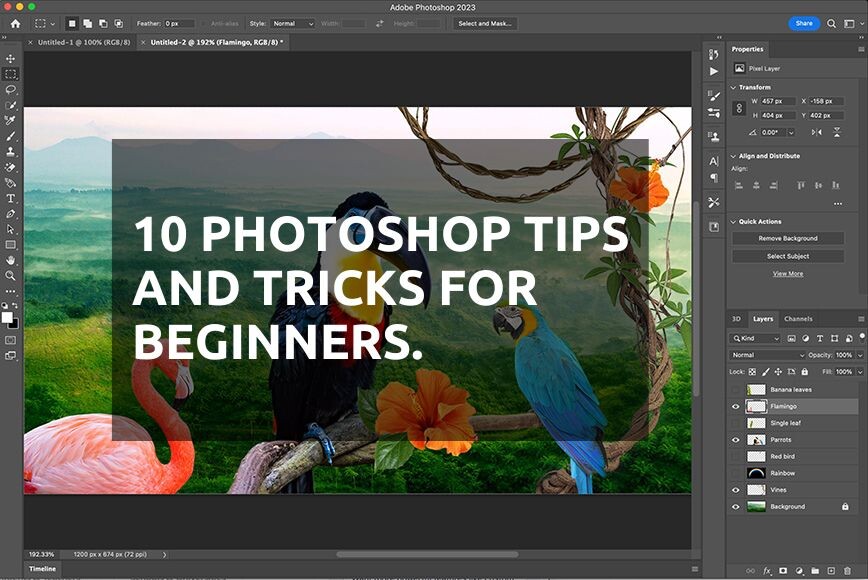If you are familiar with all of Photoshop's functions and know how to use them efficiently, it is a highly powerful tool. For those who are just starting out with Adobe Photoshop, nevertheless, that is not feasible. This blog post is a lesson on 12 simple Adobe Photoshop tips and tricks for new users that will help them enter the world of digital creating and produce beautiful artwork. Many seasoned designers choose to stick with mastering simply the fundamentals of Photoshop out of convenience, but now is your chance to get ahead of the curve.
Good designers focus on ways to increase their productivity in every way imaginable in addition to knowing about the many Photoshop capabilities. Your Photoshop productivity can be increased by completing tasks more quickly. You must master many time-saving hacks, tips, and tactics like these for this in order to improve the final product and please your clients and employers.
1. Master Keyboard Shortcuts

Keyboard shortcuts can help you save time on all types of software. They are designed to turn laborious or repetitive chores into hotkeys that you may use to complete tasks. Many keyboard shortcuts are included by default with Adobe Photoshop. You can do practically all of the activities, from saving the document to adding layers, changing brushes, transforming, and exporting, if you know the proper keyboard shortcut.
2. Switching Between RGB and CMYK

You may save time using keyboard shortcuts with various kinds of software. Their goal is to turn difficult or repetitive processes into hotkeys that you can use to do things. There are many standard keyboard shortcuts included with Adobe Photoshop. If you know the appropriate shortcut for each action, you can accomplish practically all of them, from saving the document to adding layers, changing brushes, transforming, and exporting.
3. Copy Background Layers For Editing First

This is a really basic hack that is easy to implement but has the potential to be incredibly powerful. If you already use Lightroom, you undoubtedly have a general understanding of how this operates. This advice will be helpful if your project involves employing intricate items and then further tweaking and customising them. The base image will always appear in Photoshop as the backdrop layer. Usually, designers will get to work on it right away. Instead, we suggest that you duplicate the background layer to make a new layer for this image.
4. The Fade Tool is Very Powerful

The basis of Photoshop design is based on the use of many layers. Photoshop produces a collection of layers that have been combined. A successful design depends on how these levels interact with one another. The application of the fading tool is made more important by this fundamental idea. The Fade Tool in Photoshop is used to modify the layer's transparency.
5. Adjust Photoshop Memory Usage

Regardless of the operating system, your system uses a specific amount of RAM to operate each piece of software. Photoshop typically consumes about 70% of RAM by default. Professional designers are aware that they can alter the RAM allocation for various software, nevertheless. This allows you to give Photoshop extra RAM. This will speed up Photoshop's job execution.
6. Makes the Most of the Curvature Pen Tool

In Photoshop, the most recent Curvature Pen Tool is a really helpful tool. This unique tool is available from the Pen Tool in your workspace. This tool is extremely useful since it makes it simple to build a variety of forms. Although its functionality is fairly similar to that of the current pen tool, it makes it simple for designers to produce forms with numerous nodes and curves.
7. Adjust Recovery and Background Save Options

Do you realise that Photoshop regularly saves the work you create? The majority of all large applications has access to this autosave capability. When software malfunctions or the machine abruptly shuts down, it is quite helpful. After that, you can go back to the most recent autosave point without losing your hard work. More information is provided in this video, although this autosave may slow down your productivity.
8. Culling Your Images Before Editing

This advice is intended for designers who frequently modify photos for their designs. Mobile phone cameras have made digital photography into an overindulgence issue. Your client will send you a tonne of images, and they'll want you to use the best ones. There will be numerous photographs with various stances and backdrops if you are editing a photographic assignment. We cannot overstate how crucial image culling will be to your overall productivity.
9. Master Perspective Warp

Photoshop's perspective tool is incredibly underutilised, yet it has a lot of promise for giving your design a 3D effect. Using this programme, you can even proportion your image. You must select Edit -> Perspective Warp in order to use the master perspective warp. Your cursor will change appearance, as you will see. You must now click on the image that needs fixing. The image will produce a complete grid.
10. Use Smart Objects for Instant Color Modification

The potential of smart items would be known to all designers. We did not mention that as a time-saving suggestion because of this. But what we're demonstrating here is how to quickly change the colour of your image using smart objects. You must, of course, stay within a particular colour palette when working on any design. This might alter occasionally, in which case you'll need to adjust every colour effect in the picture. There is, however, a more clever way to accomplish this.









